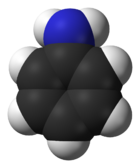Aniline dyes facts for kids
Quick facts for kids Aniline |
|
|---|---|
|
Preferred IUPAC name
Aniline
|
|
|
Benzenamine
|
|
| Other names | Phenylamine Aminobenzene Benzamine |
| Identifiers | |
| CAS number | |
| PubChem | |
| DrugBank | DB06728 |
| KEGG | C00292 |
| ChEBI | CHEBI:17296 |
| RTECS number | BW6650000 |
| SMILES | Nc1ccccc1 |
|
InChI
InChI=1/C6H7N/c7-6-4-2-1-3-5-6/h1-5H,7H2
|
|
| Beilstein Reference | 605631 |
| Gmelin Reference | 2796 |
| 3DMet | B00082 |
| Properties | |
| Molecular formula | |
| Molar mass | 0 g mol-1 |
| Appearance | Colorless liquid |
| Density | 1.0297 g/mL |
| Melting point | |
| Boiling point | |
| 3.6 g/(100 mL) at 20 °C | |
| Vapor pressure | 0.6 mmHg (20 °C) |
| Acidity (pKa) |
|
| −62.95·10−6 cm3/mol | |
| Refractive index (nD) | 1.58364 |
| Viscosity | 3.71 cP (3.71 mPa·s at 25 °C) |
| Thermochemistry | |
| Std enthalpy of combustion ΔcH |
−3394 kJ/mol |
| Hazards | |
| Main hazards | potential occupational carcinogen |
| NFPA 704 |
|
| Explosive limits | 1.3–11% |
| U.S. Permissible exposure limit (PEL) |
TWA 5 ppm (19 mg/m3) [skin] |
| Except where noted otherwise, data are given for materials in their standard state (at 25 °C, 100 kPa) | |
Aniline is a special chemical that helped create the world of bright, colorful clothes and products we see today! It's an organic compound, which means it's made mostly of carbon and hydrogen, like many things found in nature. For a long time, people used natural dyes from plants and insects to color fabrics. But these dyes could be expensive, hard to get, and sometimes faded quickly. That all changed when scientists discovered how to make amazing colors using chemicals like aniline.
Contents
What is Aniline and Why is it Important?
Aniline is a colorless liquid, but it's super important because it's a building block for many other chemicals. One of its most famous uses is in making synthetic dyes. These are dyes created in a lab, not from natural sources. Before synthetic dyes, getting vibrant colors like bright purples or deep blues was very difficult and costly. Aniline changed that by making these colors much easier and cheaper to produce.
The Discovery of Mauveine: A Colorful Accident
The story of aniline dyes really took off in 1856, thanks to a young English chemist named William Henry Perkin. He was only 18 years old! Perkin was trying to make a medicine for malaria, a disease that was a big problem back then. He was experimenting with aniline, but his experiment didn't go as planned. Instead of medicine, he noticed a strange, beautiful purple color in his flask.
This purple dye was called mauveine, or sometimes just "mauve." It was the very first synthetic organic dye ever made. Perkin quickly realized how special this discovery was. Mauveine was bright, didn't fade easily, and could color silk and cotton wonderfully. This accidental discovery kicked off a huge revolution in chemistry and fashion!
How Aniline Dyes Changed the World
After Perkin's discovery, scientists around the world started experimenting with aniline. They soon found ways to make all sorts of new colors: vibrant reds, brilliant blues, sunny yellows, and deep greens. These new synthetic dyes were a game-changer for many reasons:
- Brighter Colors: They offered colors that were much more vivid and consistent than natural dyes.
- Cheaper Production: Making dyes in a factory was much cheaper than collecting rare plants or insects.
- More Colors: The variety of colors exploded, giving designers and artists many more options.
- Fashion Revolution: Suddenly, colorful clothes were available to more people, not just the very rich. This made fashion much more exciting and accessible.
- New Industries: The discovery led to the growth of a massive chemical industry focused on making dyes and other synthetic products.
Aniline dyes quickly became essential for coloring textiles, paper, leather, and even some inks. They transformed how people dressed and how products looked.
Making Aniline Dyes Today
While many new types of dyes have been invented since Perkin's time, aniline and its related compounds are still very important in the chemical industry. Scientists and engineers have developed safer and more efficient ways to produce these dyes. They are used in a wide range of products, from the clothes we wear to the paints on our walls and the inks in our pens.
Aniline is also used to make other important things, like some types of plastics, rubber chemicals, and even some medicines. It's a versatile chemical that continues to play a big role in modern manufacturing. Because it is a chemical, it needs to be handled carefully by trained professionals to ensure safety.
Images for kids
See Also





